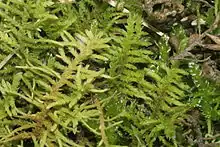Abietinella abietina
Abietinella abietina is a species of moss of the genus Abietinella in the family Thuidiaceae. It is a small, distinctive pleurocarpuous moss with stems that are erect and branches which are spreading, reminiscent of a tiny conifer. It’s extremely rare variety abietina is grown with the commoner var. hystricosa on coastal sand dunes. Abietinella abietina is a species which is perennial in terms of growing season, which means it can be found during all months of the year.[1]
| Abietinella abietina | |
|---|---|
 | |
| Abietinella abietina | |
| Scientific classification | |
| Kingdom: | Plantae |
| Division: | Bryophyta |
| Class: | Bryopsida |
| Subclass: | Bryidae |
| Order: | Hypnales |
| Family: | Thuidiaceae |
| Genus: | Abietinella |
| Species: | A. abietina |
| Binomial name | |
| Abietinella abietina (Hedw.) M. Fleisch. | |
Characteristics
Abietinella abietina shoots are of either green or dark brown. The tips of the shoots are usually yellow or green. The shoots are once-pinnate which have branches in four rows (arranged with two on each side of the stem) in two planes. Secondary stems are the length of about 5–10 cm. The leaves of the stems of Abientinella abietina are broad and oval shaped. They are longitudinally ridged and have a broad base. The leaves of the branch are smaller compared to the leaves of the stem which are bigger.[2]
Abietinella abietina has the ability to grow stems which are about 2–8 cm in length (but rarely ever 12 cm). Branches arise in four ranks from these stems. The branches are often spread out at wide angles which result in sparse branches. The leaves of Abietinella abietina are broadly ovate, patent, and they pilcate at the base and they also taper to a long acuminate apex. The leaves of the branches are rather concave and broadly ovate to lanceolate, with a rather shorter apex.[1]
Habitat
Abietinella abietina favor soils which are shallow mostly in unimproved grassland which overlies calcareous sandy soil, dune slacks, and banks in quarries. It is known to hardly ever occur on base-rich slopes or rocky ledges in mountains. It would be extremely rare if found.[2]
Similar species
A similar plant is Thiudium tamarscinum, which is 'tripinnate'; it consists of pinnately compound leaves arranged in a single plane. Because of this, it has a feathery look, more so then A. aaietina.[2]
References
- "Abietinella abietina fir tamarisk-moss :: Northern Ireland's Priority Species ::". www.habitas.org.uk. Retrieved 2018-12-18.
- "Abietinella abietina var. abietina/histricosa" (PDF). Royal Botanic Garden Edinburgh. Retrieved 2018-12-18.